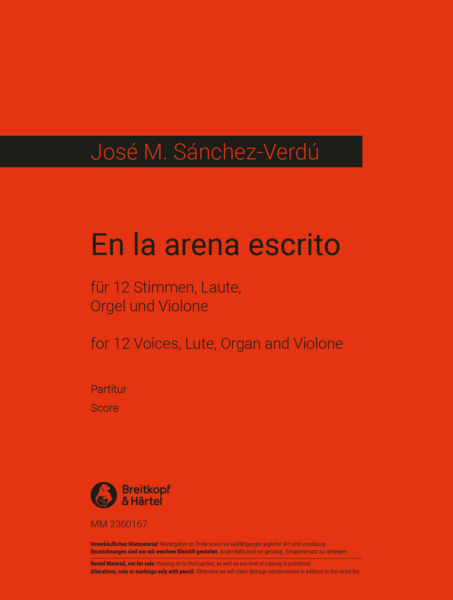José M. Sánchez-Verdú (*1968) En la arena escrito
[Soli,Lte,Org,Vle] 2022 Dauer: 14' Text: Juan de Tassis y Peralta
Soli: 4S3ABar2T2B – Lte – Org – Vle
Uraufführung: Weißenfels, Stadtkirche St. Marien, 9. Oktober 2022
Auftragswerk von AuditivVokal Dresden und Heinrich Schütz Jubiläum
En la arena escrito („Auf den Sand geschrieben“) hat als Textgrundlage ein Sonett des spanischen Autors Juan de Tassis, Graf von Villamediana (1582-1622). Das Stück besteht aus zwei Sätzen, die durch ein Interludio verbunden sind.
Raum und Resonanz spielen eine wesentliche Rolle. Das Interludio ist in der Tat ein Übergang, um einen Wechsel in der räumlichen Dramaturgie zwischen den beiden Sätzen zu schaffen. In Satz I gibt es neben der Gruppe, die sich zusammen mit den drei Instrumentalisten und dem Publikum im Hauptraum befindet, eine Gruppe von Stimmen, die sich in einiger Entfernung befindet, wie ein Chor im Echo. Im zweiten Satz jedoch wechseln die Stimmen der Hauptgruppe, und es entsteht eine komplexere Räumlichkeit, die auf zwei weit entfernten Chören basiert: Fernchor I ist weit weg, aber im Hauptraum; Fernchor II ist sehr weit weg, in einem anderen Raum ohne direkte visuelle Verbindung zum Hauptraum.
Das Werk und seine Thematik sind bewusst mit dem Topos von Tod und Trauer verbunden. Insbesondere steht dieses Diptychon den Musikalischen Exequien von Heinrich Schütz sehr nahe. En la arena escrito, der sich auf einen Text stützt, der fast zeitgleich mit der Komposition dieser Musikalischen Exequien entstanden ist, tritt mit ihnen in Dialog. Im zweiten Satz zitiert der Fernchor II stilistisch sogar einige Element aus dem dritten Teil von Schütz’s Werk.
(José M. Sánchez-Verdú, 2022)
| 1. Silencio |
| 2. Tumba y muerte |










 Blättern
Blättern